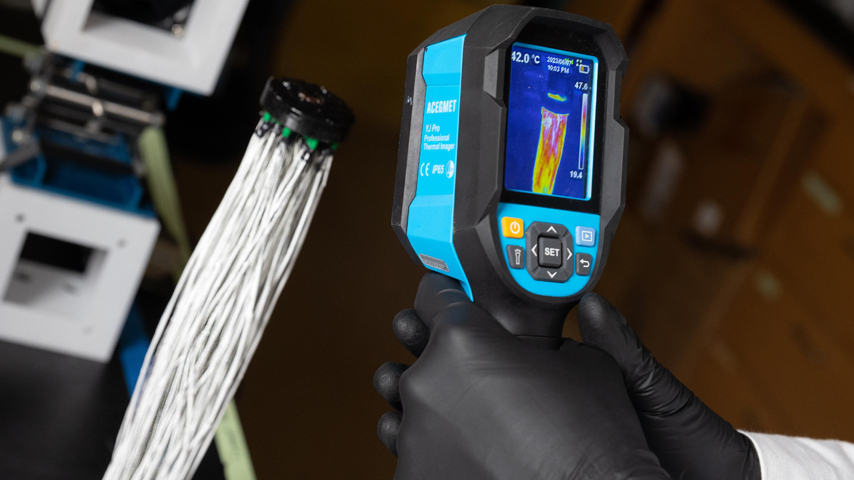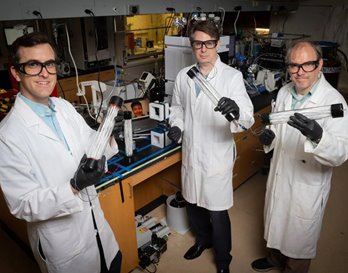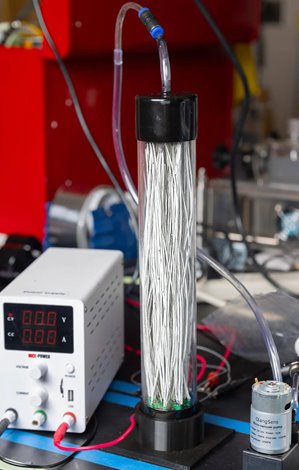Direct Air Capture Simplified with Carbon Fiber, Heat, and Wind
Direct Air Capture Simplified with Carbon Fiber, Heat, and Wind


Georgia Tech researchers are looking to simplify traditional direct air capture systems by using ambient wind flow to draw air across a new kind of coated carbon fiber to grab CO2.
Although removing carbon dioxide (CO2) directly from the atmosphere will likely be necessary to reach worldwide carbon emission reduction targets, current carbon capture technologies are almost prohibitively expensive. And to effectively purify the CO2 from whatever device is capturing it requires steam and all the equipment that comes with it: boilers, blowers, and condensers. That can use a lot of energy, but more importantly, it requires steep start-up costs. But Georgia Tech researchers have developed a possible solution.
“So, our motivation was to create a passive system that can just sit out on the ground with minimal moving parts, minimal auxiliary systems,” said Ryan Lively, a professor at Georgia Tech’s School of Chemical and Biomolecular Engineering. Lively and his team wanted to use carbon fibers combined with a carbon-capturing sorbent. When the fibers heat up, the collected purified CO2 would be whisked away and disposed of, potentially at a nearby CO2 sequestration site.
Initially, they tried carbon bricks and other solids. But creating a uniform resistance across a block of carbon proved difficult, as the bricks had uneven heating and electrical properties. Electricity would find paths of least resistance and form hot and cold spots. So, the researchers turned to sorbent-coated carbon fibers, which had uniform resistance across every fiber. That freed up the kinds of designs that could be used and opened the door to a variety of potential shapes and systems.
Become a Member: How to Join ASME
“We just weren’t sure how to deploy the fibers in a wind field,” said Lively. “We had all sorts of weird crazy ideas, like a sail, or a box.”
The answer came to him when he and his wife went to the bank to deposit a check. “We did the drive-through, and they still had the old teller tubes,” Livley explained. “I was like, ‘Oh, we can automate that and blow wind through it.’ And that’s how we ended up with that design. Usually, you iterate and fail and iterate and fail, but in this case, it did work out a little bit like in the movies.”
That moment led to the development of a tube of carbon fibers that acts as a cartridge and is key to this new system. At full scale, a group of these cartridges will be placed in a Stonehenge arrangement around a pump house. Each cartridge will have a diameter of around six inches or a foot and they can be as tall as is convenient. Lively and his colleagues are thinking that a first system will have cartridges that are roughly three feet in length.
As the cartridges become saturated with CO2, they’ll be heated up to around 180 °F, causing the CO2 to be released from the fibers. “It’s almost like a light switch. You turn on the power and the carbon fiber and sorbent coating reach regeneration temperature in 10 or 20 seconds,” said Lively.
More for You: Leading Hard-to-Decarbonize Industries to Zero Emissions
Instead of flying off into the atmosphere, the carbon will be trapped in the cylinder and then sucked away for sequestration or for use with chemicals or industry. That cycle of heating and cooling then carbon capture and release takes about 30 minutes, if all goes according to plan.
Polyethylenimine, which is the critical material for culling carbon, is also fairly inexpensive. Though the sorbent will degrade over time, it will be simple and cheap enough to reinfuse the fibers of the cartridges and reuse them. Though the system as is might use a similar amount of energy compared to other carbon capture systems, the cost of building one will likely be drastically cheaper.
“So, what we're trying to do, from an engineering perspective, is increase the amount of the active compound in the cartridge and minimize the components that don’t contribute to the separation of carbon,” said Lively. “That'll improve the efficiency and reduce costs.”
But the more immediate goal is making the transition from prototype to commercial product. “We need chemists, chemical engineers, mechanical engineers, systems folks, policy and economics folks, geologists, and civil engineers—it’s an all-hands-on-deck sort of situation,” said Lively. “This is really just a demonstration prototype that we've got so far. And now the rubber’s got to hit the road.”
Michael Abrams is a writer in Westfield, N.J.
“So, our motivation was to create a passive system that can just sit out on the ground with minimal moving parts, minimal auxiliary systems,” said Ryan Lively, a professor at Georgia Tech’s School of Chemical and Biomolecular Engineering. Lively and his team wanted to use carbon fibers combined with a carbon-capturing sorbent. When the fibers heat up, the collected purified CO2 would be whisked away and disposed of, potentially at a nearby CO2 sequestration site.
Initially, they tried carbon bricks and other solids. But creating a uniform resistance across a block of carbon proved difficult, as the bricks had uneven heating and electrical properties. Electricity would find paths of least resistance and form hot and cold spots. So, the researchers turned to sorbent-coated carbon fibers, which had uniform resistance across every fiber. That freed up the kinds of designs that could be used and opened the door to a variety of potential shapes and systems.
Become a Member: How to Join ASME
“We just weren’t sure how to deploy the fibers in a wind field,” said Lively. “We had all sorts of weird crazy ideas, like a sail, or a box.”
The answer came to him when he and his wife went to the bank to deposit a check. “We did the drive-through, and they still had the old teller tubes,” Livley explained. “I was like, ‘Oh, we can automate that and blow wind through it.’ And that’s how we ended up with that design. Usually, you iterate and fail and iterate and fail, but in this case, it did work out a little bit like in the movies.”
That moment led to the development of a tube of carbon fibers that acts as a cartridge and is key to this new system. At full scale, a group of these cartridges will be placed in a Stonehenge arrangement around a pump house. Each cartridge will have a diameter of around six inches or a foot and they can be as tall as is convenient. Lively and his colleagues are thinking that a first system will have cartridges that are roughly three feet in length.
As the cartridges become saturated with CO2, they’ll be heated up to around 180 °F, causing the CO2 to be released from the fibers. “It’s almost like a light switch. You turn on the power and the carbon fiber and sorbent coating reach regeneration temperature in 10 or 20 seconds,” said Lively.
More for You: Leading Hard-to-Decarbonize Industries to Zero Emissions
Instead of flying off into the atmosphere, the carbon will be trapped in the cylinder and then sucked away for sequestration or for use with chemicals or industry. That cycle of heating and cooling then carbon capture and release takes about 30 minutes, if all goes according to plan.
Polyethylenimine, which is the critical material for culling carbon, is also fairly inexpensive. Though the sorbent will degrade over time, it will be simple and cheap enough to reinfuse the fibers of the cartridges and reuse them. Though the system as is might use a similar amount of energy compared to other carbon capture systems, the cost of building one will likely be drastically cheaper.
“So, what we're trying to do, from an engineering perspective, is increase the amount of the active compound in the cartridge and minimize the components that don’t contribute to the separation of carbon,” said Lively. “That'll improve the efficiency and reduce costs.”
But the more immediate goal is making the transition from prototype to commercial product. “We need chemists, chemical engineers, mechanical engineers, systems folks, policy and economics folks, geologists, and civil engineers—it’s an all-hands-on-deck sort of situation,” said Lively. “This is really just a demonstration prototype that we've got so far. And now the rubber’s got to hit the road.”
Michael Abrams is a writer in Westfield, N.J.





